Abstract
Building on our previous 310-h test of a larger MEMS sensor, this study develops and validates a miniaturized, lift-off-fabricated, and FPC-integrated three-in-one microsensor. In addition to extending the operation to 744 h, we introduce a wireless MQTT/Node-RED architecture to enable real-time IoT-level monitoring in factory HVAC ducts. The microsensor was fabricated using Micro-electro-mechanical systems (MEMS) technology and integrated with a flexible printed circuit (FPC) for improved mechanical compliance and ease of installation. To assess its durability and reliability, a 744-h long-term test was conducted in an industrial HVAC environment, where the performance of the microsensor was compared with that of two commercially available velocity sensors. The integrated sensor exhibited stable operation throughout the test and demonstrated effective measurement capabilities in the ranges of 10–40 °C for temperature, 60–90% RH for humidity, and 1.5–5.0 m/s for airflow velocity, with an overall accuracy of approximately ±3%. The results highlight the sensor’s potential for real-time environmental monitoring in factory HVAC systems, offering advantages in integration, adaptability, and cost-effectiveness compared to traditional single-function commercial sensors.
1. Introduction
Existing HVAC systems primarily rely on fixed-point sensing and traditional control algorithms such as PID or rule-based logic, which may be insufficient to capture dynamic changes in duct conditions. These conventional approaches often overlook the synergistic effects of airflow velocity, temperature, and humidity—particularly in complex factory environments []. Sensor studies in building systems have shown that inadequate sensing density and latency hamper real-time control performance []. To address this, researchers have proposed adaptive and distributed HVAC control frameworks that account for spatiotemporal variations in air parameters [].
Due to the HVAC system’s mechanism of balancing environmental conditions by introducing large amounts of external air, the parameters within chilled air ducts are closely influenced by geographic location, seasonal transitions, and even short-term extreme events (e.g., typhoons or heavy rain). Such fluctuations can indirectly impact material consistency, production quality, or process stability. In cold-air duct monitoring applications, micro air velocity sensors have been deployed to validate the feasibility of in-duct sensing.
Therefore, continuous and integrated sensing of key variables (velocity, temperature, humidity), combined with real-time data analytics for determining optimal control parameters, has become critical for improving HVAC performance and ensuring manufacturing reliability. Studies integrating IoT sensing into HVAC loops have already shown promising results in energy saving and environment regulation [].
In response to these challenges, this study presents a self-developed, compact, and durable integrated three-in-one microsensor capable of simultaneously monitoring velocity, temperature, and humidity inside HVAC ducts to enable more intelligent and robust environmental regulation. This study aims to achieve wireless real-time monitoring of the environment within HVAC chilled air ducts (airflow velocity, temperature, and humidity) and establish a comprehensive data database. The research includes planning the types of sensors needed in the chilled air ducts, determining sensor placement and quantity, evaluating and procuring commercial wireless sensors of various specifications, and developing self-made wireless integrated three-in-one micro sensors (measuring airflow velocity, temperature, and humidity). Through software and hardware integration, the study will deploy both commercial wireless sensors and self-developed three-in-one micro sensors, collect key data, and conduct field verification and data comparison to optimize internal duct environment control, thereby improving process material quality and reliability.
In our recent work [], we applied the Taguchi Method to optimize the fabrication parameters of the integrated three-in-one microsensor, demonstrating significant improvements in linearity, sensitivity, and reproducibility compared to commercial devices. Building upon previous research conducted in this laboratory [], the earlier study only validated a larger-scale sensor (400 × 400 µm) without flexible packaging under a 310-h test, which limited its long-term stability and made it susceptible to oil and dust contamination in real factory environments. This current study specifically addresses these unresolved issues by further enhancing the design, packaging, and application. Technically, we incorporated a flexible printed circuit (FPC) with epoxy encapsulation to enhance oil resistance and durability, and we optimized the sensor dimensions (e.g., reducing the wind speed sensor from 400 × 400 µm to 350 × 350 µm; temperature and humidity sensors with 10 µm/10 µm line width/spacing) to improve accuracy and reliability. We also incorporated the wireless MQTT communication protocol and the Node-RED platform to facilitate factory network integration. At the application level, measurement experiments were extended from 310 to 744 h, and two commercial wind speed sensors (FS7.0.1L.195 and F660) were compared to meet the practical needs of the Internet of Things and industry. Compared to previous stability testing, this research further verifies signal stability and the absence of drift over extended periods of operation, demonstrating its feasibility in real-world HVAC environments. Overall, this research not only improves the sensor structure and packaging but also clearly addresses the limitations of our previous work and demonstrates its value and innovation in industrial applications through extended applications and long-term testing. Future plans include expanding the calibration range and validating the system under a wider range of HVAC environmental conditions.
1.1. Micro Velocity Sensor
Xie et al. [] investigated the effects of miniaturized housing structures on MEMS hot-wire anemometer performance through simulation and experimentation. Results showed that smaller pillar diameters, more pillars, and shorter pillar heights improved device performance. Djuzhev et al. [] proposed an optimized analog circuit design for MEMS resistive airflow sensors. Their findings indicated that calorimetric methods were more suitable for low airflows (0–1 m/s), while the anemometric method was better for higher airflows (>1 m/s). Sun et al. [] examined the impact of dust and oil contamination on airflow sensor performance under harsh environments, revealing that oil films as thin as 7–8 μm resulted in measurement errors exceeding 40%. Reyer et al. [] measured voltage output from vane anemometers using a USB-6002 I/O device (National Instruments (NI), Austin, TX, USA) and shunt resistors, with pulse-width modulation (PWM) signals controlled via LabVIEW to compare readings against hot-wire anemometers. Bernhardsgrutter et al. [] proposed a novel fluid-compensated thermal flow sensor method for liquids, demonstrating feasibility with a constant temperature anemometer. Ye et al. [] introduced a multifunctional hybrid triboelectric-electromagnetic nanogenerator (FT-TENG) for efficient wind energy harvesting and self-powered airflow sensing. The FT-TENG combined the high conversion efficiency of flag-surface triboelectric nanogenerators at low wind speeds with the superior performance at higher wind speeds.
1.2. Micro Temperature Sensor
He et al. [] developed ultraminiature thin-film temperature sensors using electrohydrodynamic printing, achieving excellent linearity (0.99994) and a temperature coefficient of resistance (TCR) of 937.8 ppm/°C over 20–120 °C. Shen et al. [] proposed dynamic resistance temperature sensors for IoT environmental monitoring applications, showing minimal calibration impact from power fluctuations. Lovecchio et al. [] developed integrated transparent heaters and resistive temperature sensors on glass substrates, achieving a high temperature sensitivity of 0.12 kΩ/°C with uniform heating performance. Zhang et al. [] designed a Raman distributed temperature sensing system for radiator environments under low temperatures, validating its effectiveness. Shinoda et al. [] compared temperature readings from nine wireless and two wired commercial room-temperature sensors, revealing varying sensitivity to radiation effects based on sensor type and placement. Jones et al. [] explored the linear relationship between gold’s electrical resistance and temperature, measuring heated gold samples. Li et al. [] improved indoor temperature prediction in HVAC systems by reconstructing time series data using variables such as relative humidity, solar radiation, and airflow velocity.
1.3. Micro Humidity Sensor
He et al. [] introduced a high-performance capacitive humidity sensor based on chitosan-sodium chloride composites, showing a 72-fold increase in capacitive response. Eryanto et al. [] developed a self-powered paper-based humidity sensor using MgCl2 and carbon nanotube composites, enhancing humidity sensitivity. Chu et al. [] proposed an all-optical fiber humidity sensor based on graphene oxide-coated Mach-Zehnder interferometers, achieving ultra-high sensitivity of 707.3 pm/% relative humidity (RH) and fast response/recovery times (4.8 s/8.4 s). Li et al. [] developed high-performance Eu2Sn2O7-SnO2 humidity sensors via a hydrothermal method, showing enhanced sensitivity due to increased oxygen content. Kim et al. [] designed novel capacitive humidity sensors using carbon black/polyimide composites, improving sensitivity, hysteresis, and response speed. Parimon et al. [] created humidity sensors with nano-spherical flower-like NiO structures, achieving high sensitivity in the 40–90% relative humidity range.
2. Research Method
2.1. Design and Principle of Self-Made Integrated Three-in-One Microsensor
This study used MEMS technology to develop an integrated three-in-one microsensor, and used Au with good physical and chemical properties, as well as a simple manufacturing process for the sensing material.
2.2. Micro Velocity Sensor
A wide variety of micro airflow sensors have been developed using Micro-Electro-Mechanical Systems (MEMS) technology. These sensors are typically divided into two main categories: hot-wire and calorimetric types. For the purpose of this study, hot-wire micro airflow sensors are especially suitable due to their small dimensions, low energy requirements, high responsiveness, accurate measurement capabilities, and straightforward design in both fabrication and signal processing. Hot-wire sensors detect airflow through one of three methods: Constant Temperature (CT), Constant Voltage (CV), or Constant Current (CC). Since the Arduino microcontroller utilized in this research can natively handle only voltage signals, using a current-based method would necessitate an additional current-to-voltage converter, increasing the overall system cost.
As a result, this work adopts the Constant Voltage (CV) method and employs a customized circuit to monitor voltage fluctuations. The circuit includes a Wheatstone bridge configuration and a voltage amplifier, as illustrated in Figure 1 []. The sensing resistor RSENS forms a voltage divider with RB, and the resulting signal is amplified by the first-stage amplifier (A). A variable resistor RVCR allows for baseline adjustment. The attenuator and second-stage integrator circuit (OA with CINT and RINT) help filter noise and stabilize the output VOUT, which is then sent to the microcontroller for data acquisition.
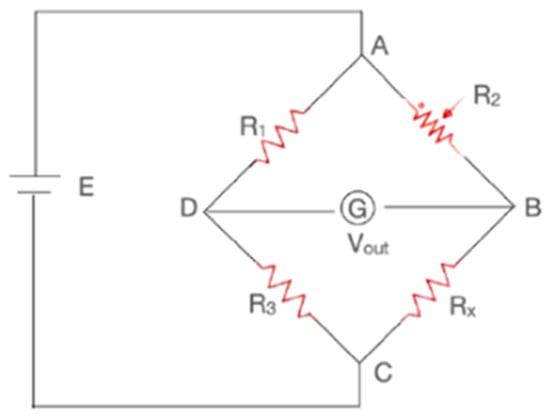
Figure 1.
Schematic diagram of Wheatstone bridge.
2.3. Micro Temperature Sensor
The micro temperature sensor employed in this research is a Resistance Temperature Detector (RTD) that utilizes gold (Au) as its electrode material. Due to thermal expansion and contraction of the metal, its electrical resistivity changes with temperature variations. To enhance the sensor’s overall resistance and sensitivity, the electrode is patterned in a serpentine layout.
The sensor is connected in a voltage divider configuration, where the voltage across the RTD changes linearly with temperature. This voltage is directly read by the analog-to-digital converter (ADC) of the Arduino microcontroller without the need for amplification, enabling a simple yet effective signal acquisition, as illustrated in Figure 2.
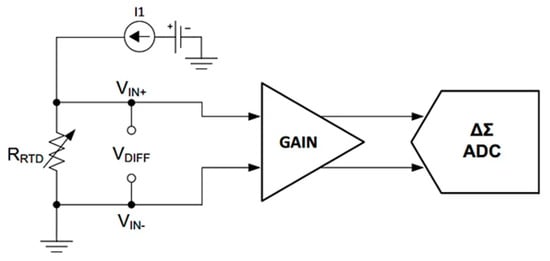
Figure 2.
Resistance Temperature Detector (RTD).
2.4. Micro Humidity Sensor
In this study, a resistive-type micro humidity sensor is utilized, employing a novel polyimide-based negative photoresist (Fujifilm LTC® PI 9305, Fujifilm, Tokyo, Japan) as its dielectric layer. This material offers excellent ductility, resistance to acids, bases, and corrosion, as well as strong moisture absorption capability. Ideally, the dielectric must remain electrically non-conductive. As the material absorbs moisture, its volume expands, leading to an increase in the resistance of the sensing circuit due to changes in the physical and dielectric properties of the moisture-sensitive layer.
The humidity sensor is also configured as a voltage divider circuit. As the resistance of the sensing material increases with humidity, the output voltage decreases. This voltage is directly acquired by the Arduino’s ADC for real-time monitoring.
2.5. Integration of Three-in-One Microsensor
Figure 3 presents the layout of the integrated three-in-one microsensor. The micro velocity sensor dimension is 350 µm by 350 µm, the micro temperature sensor dimension is 510 µm by 400 µm, and the micro humidity sensor dimension is 590 µm by 500 µm. The minimum line width and spacing used in the design are both 10 µm, with a 400 µm gap between each sensor unit. Due to their close physical proximity, the three sensors can effectively be considered as operating at the same location from a macroscopic viewpoint. As a result, the device is capable of simultaneously acquiring real-time measurements of velocity, temperature, and humidity at a single point. Table 1 summarizes the working principles of the three microsensors, detailing the sensing mechanisms and signal transduction methods applied for each physical parameter.
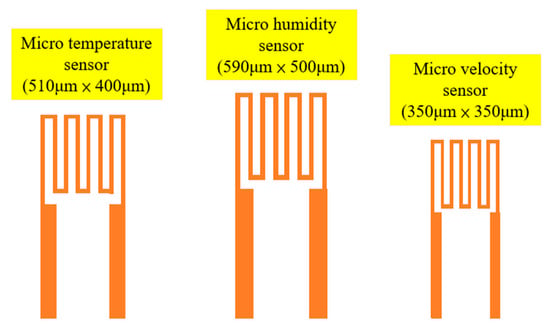
Figure 3.
Design drawing of integrated three-in-one microsensor.

Table 1.
Working principles of the three microsensors.
2.6. Process of Integrated Three-in-One Microsensor
In this study, MEMS technology was employed to integrate velocity, temperature, and humidity sensing elements into a single device. To ensure the integrated three-in-one microsensor is suitable for flexible deployment within HVAC cold air ducts, and to support long-term, stable measurements without failure, polyimide (PI) film was selected as the sensor substrate due to its excellent flexibility, corrosion resistance, high thermal stability, and mechanical stretchability. The PI substrate used has a thickness of 50 µm. For insulation and protection, liquid polyimide materials LTC® 9320 and LTC® 9305 both from Fujifilm, Tokyo, Japan were adopted as the protective and dielectric layers, respectively. To prevent damage to the flexible substrate, the surface micromachining method was implemented. The primary steps of the MEMS process include thin-film deposition, photolithography, and lift-off. In contrast to previous fabrication approaches in this laboratory that relied on wet etching—often resulting in excessive line width erosion and difficulties in aligning backend circuitry—this work transitioned to a lift-off process to enhance fabrication precision and improve the overall reliability of the microsensor. The complete fabrication procedure is illustrated in Figure 4.
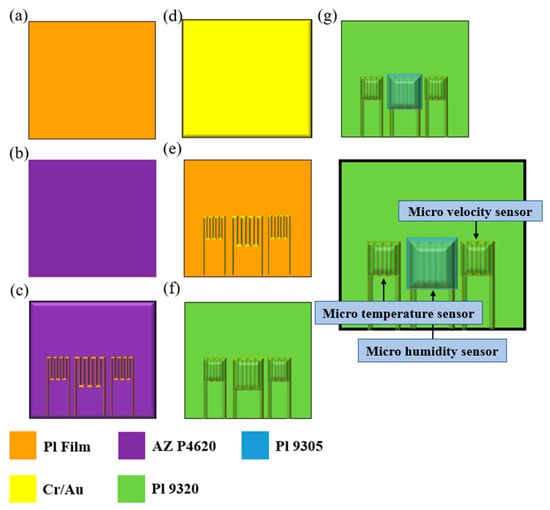
Figure 4.
Fabrication flow chart of integrated three-in-one microsensor. sensor: (a) cleaning and fixing of polyimide film; (b) coating; (c) exposure; (d) evaporation; (e) lift off; (f) protective layer fabrication; (g) dielectric layer fabrication.
- a.
- Cleaning and Fixation of Polyimide Film
First, the polyimide (PI) film is cleaned sequentially with acetone and methanol, followed by rinsing with deionized water to remove any residual methanol. This step eliminates surface dust and grease, enhancing the adhesion of metal layers to the film.
- b.
- Spin Coating
A positive photoresist (AZ® P4620, Merck Performance Materials GmbH, Wiesbaden, Germany) is uniformly applied to the substrate using a spin coater.
- c.
- Photolithography of Circuit Layer
Photolithography is performed using a double-sided mask aligner. After exposure, development is carried out using AZ® 400K developer (AZ Electronic Materials USA Corp., Branchburg, NJ, USA). To prevent overly rapid development, which may result in overdeveloped patterns, narrower line widths, and reduced yield, the developer is diluted with deionized water at a 1:4 ratio. The development process lasts approximately three minutes, after which well-defined patterns can be obtained.
- d.
- Metal Deposition
Metal layers are deposited using an electron beam evaporator. Chromium (as an adhesion layer) and gold (as the sensing layer) are deposited sequentially at a rate of 0.5–1 Å/s to achieve the specified thickness.
- e.
- Metal Lift-Off
Immediately after deposition, the lift-off process is conducted using acetone to remove the photoresist and lift off excess metal, leaving only the patterned electrodes on the substrate.
- f.
- Protective Layer
Fujifilm Durimide® PI 9320 (Fujifilm, Tokyo, Japan) is used as the protective layer material in this study. A second photolithography and development step is performed to define an insulating protective layer with high mechanical strength and chemical resistance.
- g.
- Dielectric Layer
Fujifilm Durimide® PI 9305 (Fujifilm, Tokyo, Japan) is used as the dielectric layer material. It features high mechanical strength, corrosion resistance, electrochemical stability, and flexibility. Photolithography is employed to define the sensing area and contact pads of the flexible three-in-one microsensor, exposing the humidity-sensitive layer of the micro-humidity sensor.
2.7. Back-End Integration of Integrated Three-in-One Microsensor with FPC
In earlier setups, microsensors were assembled onto ceramic substrates; however, the stiffness and mass of both the ceramics and their wire connections induced mechanical stress. Within restricted spaces, this frequently caused bending that delaminated the adhesive layer and damaged the conductive gel together with the silver-paste joints, degrading overall sensor functionality.
To overcome this problem, a flexible printed circuit (FPC) using a polyimide (PI) base was developed. This material offers outstanding bendability, resistance to chemicals, and thermal stability. The integrated three-parameter microsensor was reduced to a minimal size and bonded onto the FPC, ensuring a compact yet robust connection. This integration strategy significantly improves the mechanical resilience and long-term reliability of the system. The finalized back-end integration is presented in Figure 5, and the line pattern of the FPC is illustrated in Figure 6.

Figure 5.
Back-end integration of integrated three-in-one microsensor with FPC.
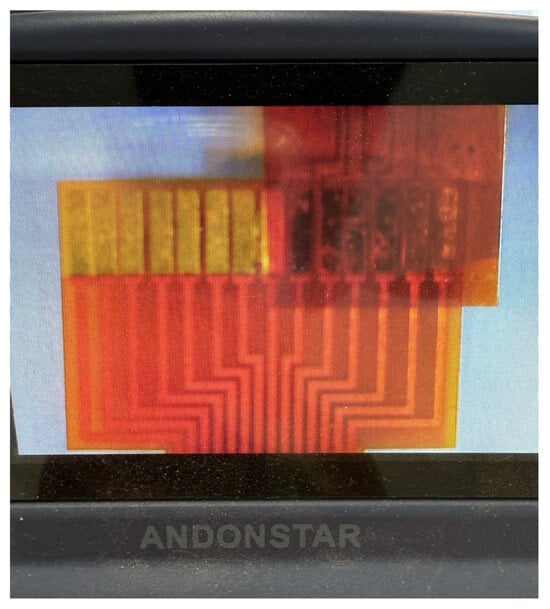
Figure 6.
Line pattern of integrated three-in-one microsensor with FPC.
2.8. Back-End Integration of Integrated Three-in-One Microsensor with FPC
To achieve secure mounting and long-term stability in the HVAC cold-air duct, the sensor package was specifically tailored to fit the original manufacturer’s mounting interface. Given the oil-laden conditions typical of such ducts, the enclosure was also required to withstand chemical exposure. A customized casing was therefore fabricated via additive manufacturing (3D printing).
The chosen material, PETG (polyethylene terephthalate glycol), offers outstanding chemical resistance and mechanical robustness []. This design ensures that the integrated three-in-one microsensor remains firmly anchored within the duct’s mounting system while being protected from physical and chemical damage. Once assembled, the device is inserted into the printed enclosure and secured, as shown in Figure 7.
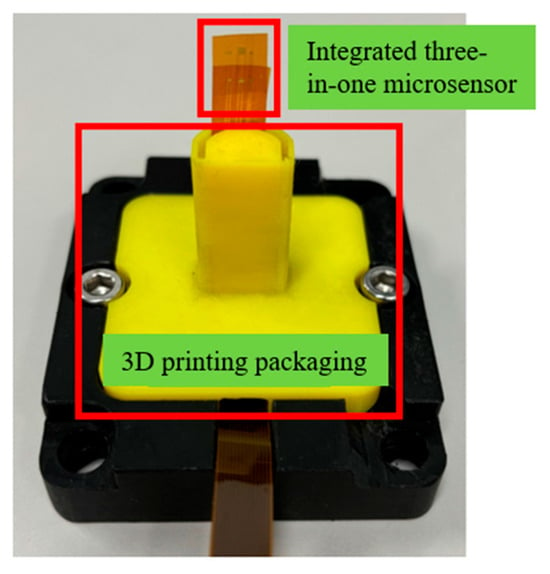
Figure 7.
Packaging of integrated three-in-one microsensor.
3. Results and Discussion
3.1. Correction of Integrated Three-in-One Microsensor
The velocity, temperature, and humidity sensors were each calibrated using the same programmable chamber to maintain consistency. All readings were taken at stable conditions after a 30-min stabilization period per setting. The test range is set as 0 m/s~10 m/s. The self-made micro velocity sensor performs velocity correction within this range, and the data are accurately recorded once with every increase of 1 m/s. Since the micro velocity sensor is very sensitive to temperature, the ambient temperature is gradually increased from 5 °C to 40 °C during the correction process. Measurements are performed at intervals of 5 °C, so as to obtain the correspondence curve of the velocity and the original voltage value read by Arduino. After dimensionless processing of the curve, a correction curve is obtained. As shown in Figure 8, Vf represents the voltage reading at current velocity, V0 is the reference voltage reading at 0 m/s, and the y-axis unit ((Vf − V0)/V0) is the dimensionless result of the voltage reading variation.
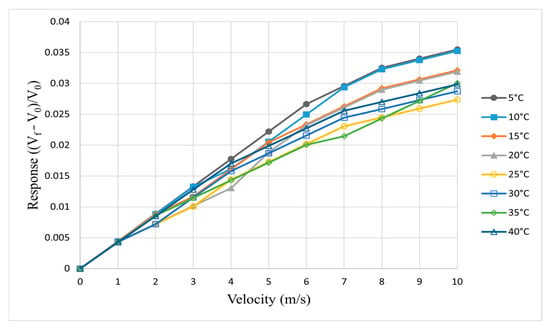
Figure 8.
Correction curve of micro velocity sensor (dimensionless).
The micro-temperature sensor was calibrated inside a programmable chamber capable of controlling both temperature and humidity. Calibration was conducted across a range from 5 °C to 40 °C, with data recorded at every 5 °C increment. Based on the Arduino-acquired raw voltage outputs, a temperature–voltage relationship curve was established. The resulting calibration curve was then normalized to a dimensionless form, as illustrated in Figure 9.
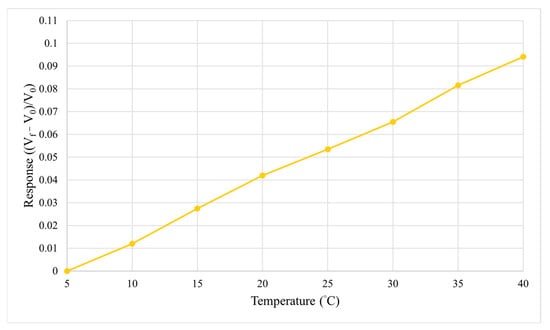
Figure 9.
Correction curve of micro temperature sensor (dimensionless).
The micro humidity sensor is placed in the programmable constant temperature and humidity testing chamber for humidity correction, ranging from 70%RH to 95%RH. The data are recorded once with every increase of 5 °C. Since the temperature influences the resistance value of the micro humidity sensor, the correction measurement is performed at intervals of 5 °C in the temperature range of 5 °C to 40 °C in the experiment, and low/high in Figure 8 refers to the humidity increase/decrease cycle. In addition, as the moisture-sensitive material has a hysteresis effect, the resistance value may change when the humidity increases or decreases. Therefore, two-way correction of humidification and dehumidification is performed in the experiment. There is a 30-min stabilization after each correction. The relation curve of humidity and the original voltage value read by Arduino is recorded. The correction curve is drawn and put into dimensionless processing, as shown in Figure 10.
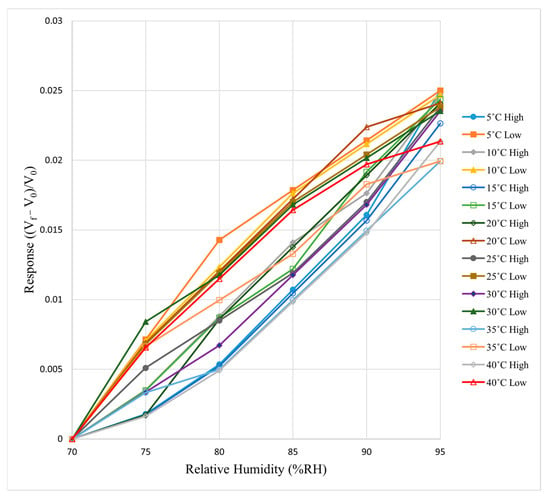
Figure 10.
Correction curve of micro humidity sensor (dimensionless).
To enhance the transparency of the measurement setup, the reference voltage V0 under baseline conditions was determined to be approximately 1.21 V for velocity sensing, 0.98 V for temperature sensing, and 0.89 V for humidity sensing. The sensing system was implemented using an Arduino Uno WiFi Rev2 microcontroller (Arduino, Monza, Italy) which supports direct analog voltage acquisition and wireless data transmission. The average noise level during sensor operation was measured to be within ±15 mV, ensuring stable and reliable signal acquisition across all sensing channels. The input bias of 15 mV applied to the Wheatstone bridge was selected based on our previous 310-h tests and Taguchi optimization results to ensure optimal ADC linearity in the 1.5–5.0 m/s airflow range while minimizing self-heating effects.
3.2. Comparison of Monitoring Data Between Self-Made Integrated Three-in-One Microsensor and Two Commercially Available Velocity Sensors
Prior to deployment, performance and oil-resistance tests were conducted on the self-developed three-in-one microsensor and two commercially available flow sensors to confirm their suitability for the HVAC environment. To guard the solder joints against oil contamination, a protective epoxy resin coating was applied to both the front and rear sides of each device. Once cured at room temperature, this coating formed an oil-impermeable layer.
Afterwards, the terminal connections of all sensors were linked to a shared power source to allow simultaneous operation, and the circuit was integrated with an Arduino microcontroller for data logging. Finally, the sensors were installed within the HVAC system’s cold-air duct, as illustrated in Figure 11.

Figure 11.
Installing sensors in the HVAC cold air duct.
Once the system is fully installed, operational data becomes available for collection. The wireless communication relies on the MQTT (Message Queuing Telemetry Transport) protocol to bridge the factory server and the internal network. Node-RED serves as the interface to read information from the intranet. In compliance with the manufacturer’s requirements, the receiving interval is set to acquire data every 15 s.
The self-made integrated three-in-one microsensor and the FS7.0.1L.195 commercial velocity sensor were tested for 744 h and compared, as shown in Figure 12, Figure 13 and Figure 14. The self-made integrated three-in-one microsensor, FS7.0.1L.195 commercial velocity and F660 commercial velocity sensor were tested for 672 h and compared, as shown in Figure 15. As seen, the variation of the self-made micro velocity sensor is ±500 mm/s, denoting the measurement variation range; the variation of the F660 commercial velocity sensor is ±800 mm/s, denoting the measurement variation range; and the variation of the FS7.0.1L.195 commercial velocity sensor is ±1000 mm/s, denoting the measurement variation range. The specifications of the two commercial wind speed sensors and the integrated three-in-one microsensor are shown in Table 2. Since the commercially available FS7.0.1L.195 velocity sensor can only measure velocity, and the F660 sensor can only measure velocity and temperature, the self-developed integrated three-in-one microsensor offers superior accuracy. It determines velocity based on different calibration curves according to ambient temperature and humidity, making it more precise than the commercial velocity sensors.
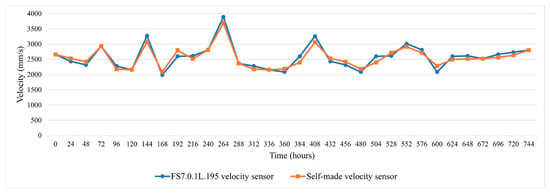
Figure 12.
744-h monitoring data of FS7.0.1L.195 commercial velocity sensor and self-made micro velocity sensor.
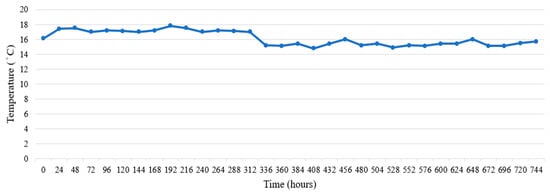
Figure 13.
744-h monitoring data of self-made micro temperature sensor.
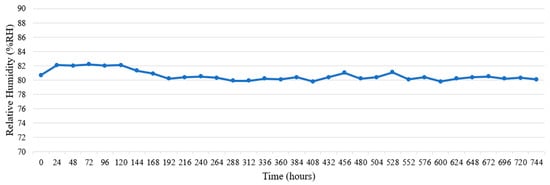
Figure 14.
744-h monitoring data of self-made micro humidity sensor.

Figure 15.
672-h monitoring data of FS7.0.1L.195 and F660 commercial velocity sensors and self-made micro velocity sensor.

Table 2.
A comparative analysis of the specifications of two commercially available wind speed sensors and the integrated three-in-one microsensor.
The 744-h continuous measurement results shown in Figure 10 and Figure 13 demonstrate that the self-made integrated microsensor maintained stable output across velocity, temperature, and humidity sensing functions. The trends observed in the microsensor data closely align with those of the commercial sensors, indicating high consistency. Notably, no signal drift or abnormal fluctuations were observed throughout the monitoring period, suggesting excellent short-term operational stability under real-world HVAC conditions. This stability can be attributed to the sensor’s flexible polyimide substrate, which ensures firm contact with the airflow stream inside the duct, minimizing mechanical vibration or installation-induced interference. These findings support the sensor’s suitability for continuous environmental monitoring applications.
4. Conclusions
In this study, a self-made integrated three-in-one microsensor capable of simultaneously measuring airflow velocity, temperature, and humidity was developed using MEMS technology and a flexible polyimide substrate. The sensor integrates all three sensing functions within a compact footprint and employs a refined lift-off process to improve pattern stability and fabrication consistency. Each sensing unit was calibrated in triplicate, and temperature was included as a factor in the correction curves to account for cross-sensitivity effects.
A 744-h continuous test was conducted inside an actual factory HVAC cold air duct. The sensor demonstrated stable output and excellent agreement with commercial reference sensors across all parameters, validating its short-term reliability in real-world operation. In addition, wireless transmission using Arduino and MQTT enabled real-time data collection and potential integration into IoT platforms.
Although the sensor performed well under local HVAC conditions (5–40 °C, 70–95% RH), we acknowledge that the current calibration range may not yet cover the full spectrum of global HVAC environments, such as extremely cold or dry regions. Future work will focus on expanding the calibration range and validating sensor performance under broader climate scenarios, ensuring its applicability to international industrial and building management systems.
In conclusion, the proposed flexible microsensor shows strong potential for smart HVAC monitoring and environmental sensing. With further advancements in durability testing, calibration coverage, and scalable manufacturing, it may serve as a practical sensing solution for modern, space-limited, and dynamic air control environments worldwide.
Author Contributions
The work presented here was carried out in collaboration between all authors. C.-Y.L. and J.-S.S. conceived, designed, and discussed this study. G.-Q.H., C.-K.L., N.C. and C.-H.C. performed the experiments and analyzed the data. All authors have contributed, reviewed, and improved the manuscript. All authors have read and agreed to the published version of the manuscript.
Funding
The authors would like to thank the National Science and Technology Council of R.O.C. for its financial support through the grants MOST 110-2221-E-155-061 and 111-2221-E-155-048.
Data Availability Statement
The original contributions presented in this study are included in the article. Further inquiries can be directed to the corresponding author.
Acknowledgments
The authors would like to thank the Far Eastern Fibertech Co., Ltd., and YZU Fuel Cell Center and NENS Common Lab for providing access to their research facilities.
Conflicts of Interest
The authors declare no conflict of interest.
References
- Zhu, X.; Li, H. Heating, Ventilation, and Air Conditioning (HVAC) Temperature and Humidity Control Optimization Based on Large Language Models (LLMs). Energies 2025, 18, 1813. [Google Scholar] [CrossRef]
- Bae, Y.; Bhattacharya, S.; Cui, B.; Lee, S.; Li, Y.; Zhang, L.; Im, P.; Adetola, V.; Vrabie, D.; Leach, M.; et al. Sensor impacts on building and HVAC controls: A critical review for building energy performance. Adv. Appl. Energy 2021, 4, 100068. [Google Scholar]
- Jazizadeh, F.; Ghahramani, A.; Becerik-Gerber, B. Adaptive and Distributed Operation of HVAC Systems for Improved Energy Efficiency and Indoor Air Quality. Appl. Energy 2020, 278, 107089–107102. [Google Scholar]
- Tanasiev, V.; Pluteanu, Ș; Necula, H.; Pătrașcu, R. Enhancing monitoring and control of an HVAC system through IoT. Energies 2022, 15, 924. [Google Scholar] [CrossRef]
- Lee, C.; Shieh, J.; Huang, G.; Liu, C.; Cox, N.; Chou, C. Enhancing the Reliability and Durability of Micro-Sensors Using the Taguchi Method. Processes 2025, 13, 2852. [Google Scholar] [CrossRef]
- Lee, C.; Shieh, J.; Chen, J.; Wang, X.; Liu, C.; Wei, C. The Application of a Self-Made Integrated Three-in-One Microsensor and Commercially Available Wind Speed Sensor to the Cold Air Pipe of the Heating, Ventilation, and Air Conditioning in a Factory for Real-Time Wireless Measurement. Sensor 2023, 23, 4471. [Google Scholar] [CrossRef]
- Xie, Y.; Wang, Y.; Yi, Z.; Qin, M.; Huang, Q.A. Simulation and Experiment of Miniaturized Housing Structure for MEMS Thermal Wind Sensors. Sens. Actuators A Phys. 2022, 333, 113297–113306. [Google Scholar] [CrossRef]
- Djuzhev, N.A.; Ryabov, V.T.; Demin, G.D.; Makhiboroda, M.A.; Evsikov, I.D.; Pozdnyakov, M.M.; Bespalov, V.A. Measurement System for Wide-Range Flow Evaluation and Thermal Characterization of MEMS-Based Thermoresistive Flow-Rate Sensors. Sens. Actuators A Phys. 2021, 15, 112832–112840. [Google Scholar] [CrossRef]
- Sun, Z.; Wang, Y.; Yuan, C. Influence of Oil Deposition on the Measurement Accuracy of a Calorimetric Flow Sensor. Measurement 2021, 10, 110052–110061. [Google Scholar] [CrossRef]
- Reyer, S.; Awiszus, S.; Meissner, K.; Muller, J. High Precision Laboratory Dryer for Thin Layer and Bulk Drying with Adjustable Temperature, Relative Humidity and Velocity of the Drying Air. HardwareX 2020, 8, 133–152. [Google Scholar] [CrossRef] [PubMed]
- Bernhradsgrutter, R.E.; Hepp, C.J.; Wollenstein, J.; Schmitt, K. Fluid-Compensated Thermal Flow Sensor: A Combination of the Three Method and Constant Temperature Anemometry. Sens. Actuators A Phys. 2022, 23, 114116–114140. [Google Scholar] [CrossRef]
- Ye, C.; Dong, K.; An, J.; Yi, J.; Peng, X.; Ning, C.; Wang, Z.L. A Triboelectric–Electromagnetic Hybrid Nanogenerator with Broadband Working Range for Wind Energy Harvesting and a Self-Powered Wind Speed Sensor. ACS Energy Lett. 2021, 7, 1443–1452. [Google Scholar] [CrossRef]
- He, Y.; Li, L.; Su, Z.; Xu, L.; Guo, M.; Duan, B.; Wang, W.; Cheng, B.; Sun, D.; Hai, Z. Electrohydrodynamic Printed Ultra-Micro AgNPs Thin Film Temperature Sensors Array for High-Resolution Sensing. Micromachines 2023, 14, 1621. [Google Scholar] [CrossRef]
- Shen, Y.; Li, H.; Cantatore, E.; Harpe, P. A Dynamic Resistive Temperature Sensor with Fully Integrated Corrections. IEEE 2023, 6, 173–176. [Google Scholar] [CrossRef]
- Lovecchio, N.; Meo, V.D.; Caputo, D.; Nascetti, A.; Crescitelli, A.; Espos, E. Transparent Oxide/Metal/Oxide Thin Film Heater with Integrated Resistive Temperature Sensors. IEEE Sens. J. 2021, 21, 18847–18855. [Google Scholar] [CrossRef]
- Zhang, J.; Wei, P.; Liu, Q. Monitoring a Heatsink Temperature Field Using Raman-Based Distributed Temperature Sensor in a Vacuum and −173 °C Environment. Sensors 2019, 19, 4186. [Google Scholar] [CrossRef]
- Shinoda, J.; Mylonas, A.; Earnings, O.B.; Tanabe, S.; Olesen, B.W. Differences in Temperature Measurement by Commercial Room Temperature Sensors: Effects of Room Cooling System, Loads, Sensor Type and Position. Energy Build. 2021, 231, 110630–110642. [Google Scholar] [CrossRef]
- Jones, G.R.; Vincent, T.; Luca, A.D.; Longobardi, G.; Eblabla, A.; Elgaid, K.; Wotherspoon, T. GaN-on-Si Thermoresistive Flow Sensor with Gold Hot-Wire. In Proceedings of the IEEE Sensors, Montreal, QC, Canada, 27–30 October 2019; pp. 1–4. [Google Scholar]
- Li, Z.; Wang, P.; Zhang, J.; Mu, S. A Strategy of Improving Indoor Air Temperature Prediction in HVAC System Based on Multivariate Transfer Entropy. Build. Environ. 2022, 219, 109164–109181. [Google Scholar] [CrossRef]
- He, A.; Yan, H.; Zheng, G.; Zhou, R.; Li, Y.; Ye, Z.; Zhang, C. A High-Sensitive Capacitive Humidity Sensor Based on Chitosan-Sodium Chloride Composite Material. Colloids Surf. A Physicochem. Eng. Asp. 2024, 699, 134740–134750. [Google Scholar] [CrossRef]
- Eryanto, G.; Tseng, S.F. Self-Powered Paper-Based Humidity Sensors with MgCl2/CNTs Composites. Sens. Actuators A Phys. 2024, 376, 115606–115613. [Google Scholar] [CrossRef]
- Chu, R.; Tan, Y.Z.; Zhou, F.; Liu, Y. Sensitivity-Enhanced Humidity Sensor Based on a Surface Core Fiber Decorated with Graphene Oxide. Sens. Actuators Rep. 2024, 8, 100207–100213. [Google Scholar] [CrossRef]
- Li, P.; Yu, S.G.; Liang, C.Y.; Wang, X. Preparation and Properties Study of High Performance Eu2Sn2O7–SnO2 Composites Humidity Sensor. Ceram. Int. 2024, 50, 24662–24669. [Google Scholar] [CrossRef]
- Kim, J.; Cho, J.H.; Lee, H.M.; Hong, S.M. Capacitive Humidity Sensor Based on Carbon Black/Polyimide Composites. Sensors 2021, 21, 1974. [Google Scholar] [CrossRef] [PubMed]
- Parimon, N.; Mamat, M.H.; Banu, I.B.S.; Vasimalai, N.; Ahmad, M.K.; Suriani, A.B.; Mohamed, A.; Rusop, M. Fabrication, Structural, Optical, Electrical, and Humidity Sensing Characteristics of Hierarchical NiO Nanosheet/Nanoball-Flower-Like Structure Films. J. Mater. Sci. Mater. Electron. 2020, 31, 11673–11687. [Google Scholar] [CrossRef]
- Vordos, N.; Gkika, D.A.; Bandekas, D.V. Wheatstone Bridge and Bioengineering. J. Eng. Sci. Technol. Rev. 2020, 13, 4–6. [Google Scholar] [CrossRef]
- Vamshinath, K.; Kumar, N.N.; Kumar, R.T.; Nagaraju, D.S.; Sateesh, N.; Subbaiah, R. Analysis of the Effect of the Process Parameter on the Mechanical Strength of 3D Printed and Adhesively Bonded PETG Single Lap Joint. Mater. Today Proc. 2022, 62, 4509–4514. [Google Scholar] [CrossRef]
Disclaimer/Publisher’s Note: The statements, opinions and data contained in all publications are solely those of the individual author(s) and contributor(s) and not of MDPI and/or the editor(s). MDPI and/or the editor(s) disclaim responsibility for any injury to people or property resulting from any ideas, methods, instructions or products referred to in the content. |
© 2025 by the authors. Licensee MDPI, Basel, Switzerland. This article is an open access article distributed under the terms and conditions of the Creative Commons Attribution (CC BY) license (https://creativecommons.org/licenses/by/4.0/).